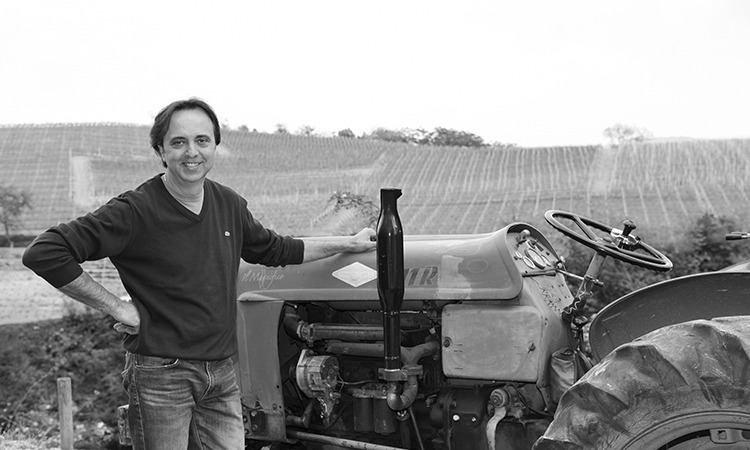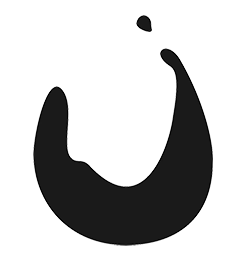2019 Cascina Fontana Barbera d’Alba
Barbera, more than any other wine, is ‘il vino del contadino’, humble yet profoundly tied to a majestic land that it’s from. It is probably the most Piedmontese of all wines. Barbera is also a great place to start if you are just getting into Italian reds. It is a smooth introduction to Italy and a great crowd-pleaser for dinner parties.
Sustainable farming practices, native yeast fermentation, unfined and unfiltered.

“I learned winemaking from my grandfather Saverio and I still do many things come una volta — as in the past, as my grandfather himself would have done. I pride myself above all on making genuine wines that are natural, true expressions of nostro territorio – our land and our culture.” – Mario Fontana, Winemaker
Cascina Fontana is located in the heart of the Barolo wine zone in the small hamlet of Perno, near Monforte d’Alba and about 15 km from Alba. Here the Fontana family continue cultivating grapes and making wine as they have done for the past six generations.
Today winemaker Mario Fontana continues this tradition, overseeing the entire cycle of production, from the tending of the vineyards to the making of the wines, taking the greatest and most meticulous care at every stage of the process.
Mario and Luisa Fontana are the proprietors of 5 hectares (about 12.5 acres) of estate vineyards dedicated exclusively to the cultivation of the classic grape varieties of Le Langhe: dolcetto, barbera and nebbiolo. The vineyards are located in the best zones of production in the commune of Castiglione Falletto (vigna Valletti,cru Mariondino, vigna Villero/cru Villero e vigna del Pozzo); La Morra (vigna Gallinotto/cru Giachini); and Sinio (vigna del Castello).
Cascina Fontana is wholly traditional wine estate that respects and follows the culture, traditions and history of Le Langhe.
“My ancestors cultivated these lands before me, and thanks to their efforts, today it is my privilege to be able to produce great wines.”
Great wine is born in the vineyard: the role of the winemaker to intervene as little as possible in order to result in a finished wine that is as pure an expression as possible of the grapes and the land which has given it birth.
Thus, after a year of toil in the vineyard, the time the grapes are ready to harvest is ‘il momento della verità’ – the moment of truth. All of the year’s efforts and toil have led to this vital and very special moment. Intuitive decisions that have been made throughout the year, in the depth of winter, during the spring rains, or in the heat of midsummer cannot now be undone. There really is no turning back.
This, says Mario, is ‘la prova di tutto il lavoro che hai fatto’ – the proof of all the hard work that has been carried out.
The different grape varieties all reach optimum ripeness at different times, and this can vary quite considerably from vineyard to vineyard. Mario carefully monitors sugar and acidity levels, as the grapes approach maturity. Dolcetto is always the most precocious, normally harvested in early September. Barbera should be ready to pick by the end of September. Nebbiolo, a notoriously late ripening variety, can be ready from the middle of October until the end of the month.
The grapes are all harvested by hand by skilled pickers. If the weather is hot, then the harvest takes place in the cooler hours of morning or evening. The grapes are placed in small, clean plastic crates that can be stacked without crushing the fruit below. They are then transported directly and as quickly as possible to the wine cantina in Perno where they are immediately pressed.
By ensuring that grapes have been picked at the optimum moment, under the best conditions, by skilled grape pickers, then taken to the wine cantina as quickly as possible, Mario is able to start with the finest primary material from which to make his wines.
Mario’s approach to winemaking is essentially rooted in his grandfather Saverio’s methods, even if the equipment used today is modern. Once the grapes arrive in the cantina, they are de-stemmed and lightly crushed to break the skin in order to allow the juice to run out. The crushed grapes are then pumped into stainless steel vats where fermentation begins spontaneously, as the natural yeast present on the skin of the grapes begins to feed on sugar.
The length of fermentation depends on the grape variety. Generally speaking, for wines that are destined to undergo more lengthy maturation, the fermentation is both longer and slower, which allows for a greater extract of tannin and other natural components that are necessary for ageing in both botte (large cask) and eventually bottle. Dolcetto, the grape variety that is always harvested earliest, undergoes a fermentation of just six to seven days and is ready to drink in the summer after the harvest. The fermentation of barbera grapes usually lasts from ten to twelve days. Nebbiolo for the production of Langhe Nebbiolo ferments for upwards of fifteen days, while fermentation of nebbiolo for the production of Barolo can sometimes last as long as forty days.
After fermentation has completed, Dolcetto wine continues to mature in stainless steel vats. Barbera and Langhe Nebbiolo mature in a mix of large botte and used 225 litre barrique for one year. Nebbiolo destined to become Barolo is aged in large Slavonian oak casks for a minimum of two years, then the wine is assembled and further aged in cement vats for a year. Once bottled, all the wines age for a further six month prior to release.
“I prefer to keep my wines as natural as possible, intervening only when necessary. The wines of Cascina Fontana stabilise naturally through the vats being placed outside in the cold during winter. I prefer not to filter wines as I believe that through filtering you inevitably lose some of the goodness of the wine. This means that in some years there will be a natural deposit in the bottle.”
A winemaker has to make hundreds of critical decisions throughout the year, guided by their own house style and philosophy. At Cascina Fontana, care and respect for tradition shape such decisions and allow Mario Fontana to produce wines that are a genuine expression of the land from which they are born: Le Langhe.
Related Items
-
2021 Clos La Coutale Cahors Malbec (half-bottle)
$16.00Cahors is the sneakily sophisticated but humbler country cousin of Bordeaux. It’s the ancestral home of Malbec and it captures everything that makes this estate beloved by sommeliers, importers, and everyday drinkers alike: depth without heaviness, structure without austerity, and earthy charm wrapped in juicy fruit. This is one of our favorite party picks.
Organic farming practices and aged for a year in French oak barrels.
-
2024 Domaine de Fontsainte ‘Gris de Gris’ Corbieres Rosé
$24.00This rosé is a staff favorite year after year. Need a bottle to grab for book club? Check. Or a glass to enjoy while you’re tending the grill? Look no further. It’s a classic, featherweight expression of the South of France and an easy go-to.
Certified HVE Level 3 (High Environmental Value) sustainable farming practices, hand-harvested, fermentation in cement and light filtered before bottling.
-
2022 Robert Biale “Black Chicken” Zinfandel Napa Valley (half-bottle)
$32.00Showing the influence of the breezy and fog-laced Oak Knoll District, this wine offers plush fruit with delicate acidity, and a structure defined by well-ripened, fine-grained tannins. Layered notes of blackberry preserves, stewed cherries, ripe plums, raspberries, violet, cocoa, and spiced wood. Persistent and full on the palate, this is an expressive Zinfandel that is drinking beautifully now, but will continue to improve for the next 5-7 years.
Certified sustainable farming practices. Family-owned winery. Dry-farmed vines and hand-harvested.
-
2021 Envinate ‘La Santa de Ursula’ Tinto Canary Islands
$65.00The Envínate group of friends are making some of the most exciting and honest wines being produced in Spain today. Their wines offer a clear & concise expression of the terruño of each land parcel that they come from.
Produced from parcels in the Santa Úrsula area with centenarian vines planted between 350–650m on volcanic soils, this red blend is known for its floral, peppery, and herbal nose–Expect juicy red fruits with a long, clean, ethereal saline-mineral finish and fine tannins. Lively, tense, and purely authentic, this is a wine that is drinkable now.
organic farming practices, hand-harvested, foot-trodden grapes, native yeast fermentation, partial whole bunch fermentation in concrete tanks & raised 8 mo. on the lees 228L neutral French oak barrels






